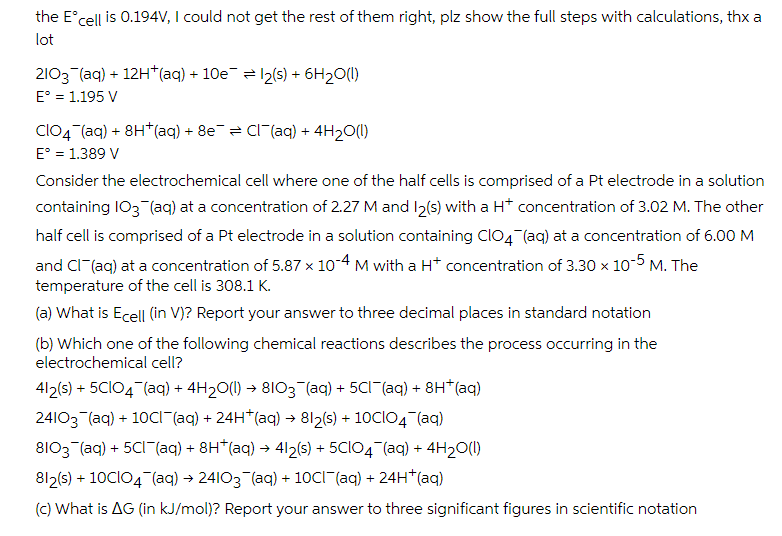the E°cell is 0.194V, I could not get the rest of them right, plz show the full steps with calculations, thx a lot 2103 (aq) + 12H*(aq) + 10e = l2(s) + 6H20(1) E° = 1.195 V ClO4 (aq) + 8H*(aq) + 8e= CI (aq) + 4H20(1) E° = 1.389 V Consider the electrochemical cell where one of the half cells is comprised of a Pt electrode in a solution containing 103 (aq) at a concentration of 2.27 M and I2(s) with a H* concentration of 3.02 M. The other half cell is comprised of a Pt electrode in a solution containing CIO4 (aq) at a concentration of 6.00 M and CI (aq) at a concentration of 5.87 × 10-4 M with a H* concentration of 3.30 x 10-5 M. The temperature of the cell is 308.1 K. (a) What is Ecell (in V)? Report your answer to three decimal places in standard notation (b) Which one of the following chemical reactions describes the process occurring in the electrochemical cell? 412(s) + 5CIO4 (aq) + 4H20(1) → 81O3 (aq) + 5CI (aq) + 8H*(aq) 24103 (aq) + 10CI"(aq) + 24H*(aq) → 8l2(s) + 10CIO4 (aq) 8103 (aq) + 5CI (aq) + 8H*(aq) → 412(s) + 5CIO4 (aq) +. - 4H20(1) 812(s) + 10CIO4 (aq) → 24103 (aq) + 10CI (aq) + 24H*(aq) (c) What is AG (in kJ/mol)? Report your answer to three significant figures in scientific notation
the E°cell is 0.194V, I could not get the rest of them right, plz show the full steps with calculations, thx a lot 2103 (aq) + 12H*(aq) + 10e = l2(s) + 6H20(1) E° = 1.195 V ClO4 (aq) + 8H*(aq) + 8e= CI (aq) + 4H20(1) E° = 1.389 V Consider the electrochemical cell where one of the half cells is comprised of a Pt electrode in a solution containing 103 (aq) at a concentration of 2.27 M and I2(s) with a H* concentration of 3.02 M. The other half cell is comprised of a Pt electrode in a solution containing CIO4 (aq) at a concentration of 6.00 M and CI (aq) at a concentration of 5.87 × 10-4 M with a H* concentration of 3.30 x 10-5 M. The temperature of the cell is 308.1 K. (a) What is Ecell (in V)? Report your answer to three decimal places in standard notation (b) Which one of the following chemical reactions describes the process occurring in the electrochemical cell? 412(s) + 5CIO4 (aq) + 4H20(1) → 81O3 (aq) + 5CI (aq) + 8H*(aq) 24103 (aq) + 10CI"(aq) + 24H*(aq) → 8l2(s) + 10CIO4 (aq) 8103 (aq) + 5CI (aq) + 8H*(aq) → 412(s) + 5CIO4 (aq) +. - 4H20(1) 812(s) + 10CIO4 (aq) → 24103 (aq) + 10CI (aq) + 24H*(aq) (c) What is AG (in kJ/mol)? Report your answer to three significant figures in scientific notation
Principles of Instrumental Analysis
7th Edition
ISBN:9781305577213
Author:Douglas A. Skoog, F. James Holler, Stanley R. Crouch
Publisher:Douglas A. Skoog, F. James Holler, Stanley R. Crouch
Chapter30: Capillary Electrophoresis, Electrochromatography, And Field-flow Fractionation
Section: Chapter Questions
Problem 30.9QAP
Related questions
Question
please explain and answer all parts

Transcribed Image Text:the E°cell is 0.194V, I could not get the rest of them right, plz show the full steps with calculations, thx a
lot
2103 (aq) + 12H*(aq) + 10e¯ = 12(s) + 6H20(1)
E° = 1.195 V
clo4 (aq) + 8H*(aq) + 8e = CI (aq) + 4H2O(1)
E° = 1.389 V
Consider the electrochemical cell where one of the half cells is comprised of a Pt electrode in a solution
containing 103 (aq) at a concentration of 2.27 M and I2(s) with a H* concentration of 3.02 M. The other
half cell is comprised of a Pt electrode in a solution containing CIO4 (aq) at a concentration of 6.00 M
and CI (aq) at a concentration of 5.87 x 10-4 M with a H* concentration of 3.30 x 10-5 M. The
temperature of the cell is 308.1 K.
(a) What is Ecell (in V)? Report your answer to three decimal places in standard notation
(b) Which one of the following chemical reactions describes the process occurring in the
electrochemical cell?
412(s) + 5CIO4 (aq) + 4H20(1) → 8103 (ag) + 5CI (aq) + 8H* (ag)
24103 (aq) + 10CI (aq) + 24H*(aq) → 812(s) + 10CIO4 (aq)
8103 (aq) + 5CI (aq) + 8H*(aq) → 412(s) + 5CIO4 (aq) +
4H20(1)
812(s) + 10CIO4 (aq) → 24103 (aq) + 10CI (aq) + 24H*(aq)
(c) What is AG (in kJ/mol)? Report your answer to three significant figures in scientific notation
Expert Solution
This question has been solved!
Explore an expertly crafted, step-by-step solution for a thorough understanding of key concepts.
Step by step
Solved in 4 steps

Knowledge Booster
Learn more about
Need a deep-dive on the concept behind this application? Look no further. Learn more about this topic, chemistry and related others by exploring similar questions and additional content below.Recommended textbooks for you

Principles of Instrumental Analysis
Chemistry
ISBN:
9781305577213
Author:
Douglas A. Skoog, F. James Holler, Stanley R. Crouch
Publisher:
Cengage Learning

Principles of Instrumental Analysis
Chemistry
ISBN:
9781305577213
Author:
Douglas A. Skoog, F. James Holler, Stanley R. Crouch
Publisher:
Cengage Learning